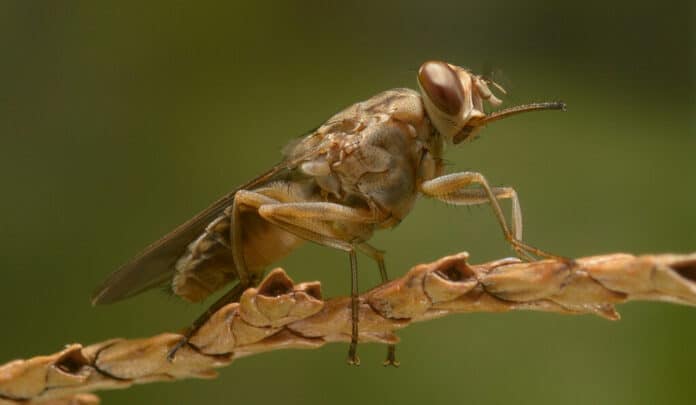Tsetse flies are vectors of trypanosomes that cause human and animal diseases in sub-Saharan Africa. Historically these flies and the trypanosomes they transmit have had extremely detrimental effects on the health and development of this region. Despite more than a century of tsetse research, volatile sex pheromones have not been identified.
In a new study, Yale scientists identified a volatile pheromone emitted by the tsetse fly. The finding provides fresh information on how flies communicate with one another and may lead to new approaches to managing fly populations and the dangerous diseases they transmit.
When the Tsetse flies bite humans or animals, they transmit parasites called African trypanosomes, spreading diseases such as African sleeping sickness, which can be fatal to humans, and nagana, a disease that affects livestock and other animals.
John Carlson, the Eugene Higgins Professor of Molecular, Cellular, and Developmental Biology in Yale’s Faculty of Arts and Sciences and senior study author, said, “African sleeping sickness is a dreadful disease that’s hard to treat. Our immune systems have difficulty clearing trypanosomes, and most of the drugs we have to kill them are toxic. And nagana, which affects livestock, has had terrible economic impacts in the region.”
Using their pheromones, particularly volatile pheromones, or pheromones that function over distances rather than through direct touch, to attract and capture the insects has been suggested as one method to prevent the spread of tsetse flies.
The Yale research team selected tsetse flies of the species G. morsitans and placed them in a liquid to collect any compounds they could produce to find volatile pheromones that might be employed for this purpose. Scientists next subjected those extracts to a gas chromatograph-mass spectrometer, a tool that can isolate particular molecules from a mixed mixture.
Scientists found several chemicals that had never previously been reported, including three that elicited responses from tsetse flies. One in particular, a chemical called methyl palmitoleate (MPO), had the strongest effects. Scientists found that MPO attracted male tsetse flies, made them stop and stay in place for a while, and had an aphrodisiac impact in a series of tests.
A drop of liquid containing MPO attracted male Tsetse flies to knots in yarn that only resembled flies and to females of another tsetse fly species that they would not typically interact with.
The scientists then investigated whether neurons on the flies’ antennae responded to MPO to comprehend how MPO mediated behavior. They discovered a subset of olfactory neurons on the antennae and found that these neurons fired more frequently in response to the pheromone.
Scientists noted, “Together, the findings indicate that MPO is a tsetse fly attractant, and therefore, it may be useful in slowing disease spread.”
Carlson said, “Now we’ve found this pheromone that could be used with the host odors. Especially since MPO attracts the flies and causes them to freeze where they are.”
“While animal odors benefit from attracting tsetse flies across large distances, they tend to fade quickly. MPO works at shorter distances but is effective for longer periods.”
“MPO could be one more tool in the toolbox when it comes to combatting tsetse flies and the diseases they spread.”
Scientists are now testing whether MPO is useful in traps in the real world, not just in a lab setting. They are also looking forward to understanding what causes Tsetse flies infected with trypanosomes to emit an entirely different set of chemicals and how that affects fly communication.
Journal Reference:
- Shimaa A. M. Ebrahim et al. A volatile sex attractant of tsetse flies. Science. DOI: 10.1126/science.ade1877
